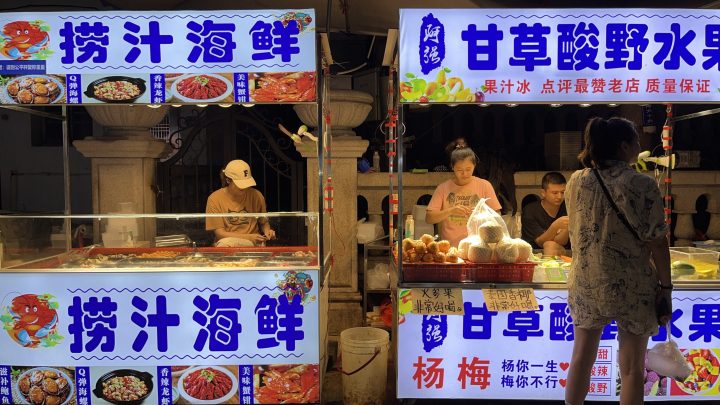
What China’s domestic tourism recovery looks like at a seafood market
What China’s domestic tourism recovery looks like at a seafood market

In the eastern Chinese city of Xiamen, crowds walk through the Eighth Seafood Market, or Bashi, past loud megaphones blasting ads for sea worm jelly, fresh fruit juice and snacks.
A stall vendor offers samples of dried local mango that cost $2.75 a pack.
“If you like the dried mangos, scan the QR code on the package to order more from us,” the owner said, adding that business is now better than pre-pandemic levels.
“During the pandemic, we didn’t have people from [the rest of China and foreign tourists], but we had a lot of local tourists to make up for it.”
In the first half of 2023, China’s tourism ministry said that people made 2.4 billion trips domestically and spent 2.3 trillion yuan ($315 billion), recovering to 77% and 83% respectively of pre-COVID-19 levels.
Xiamen’s Bashi looks livelier than in December, when Marketplace last visited. At the time, the government had dropped the zero-COVID restrictions abruptly. The first wave of COVID infections swept through the country, and many people were sick at home, leaving the seafood market nearly empty.

Eight months later, the crowds, the shops and their loud megaphones are back. Restaurants with seafood tanks filled with varieties of clams, shrimps, crabs and lobsters line one end of the street. The restaurants often don’t have menus and set prices. They’re intimidating even for local Chinese people.
Marketplace visited A Mi, the same restaurant that we stopped by in December. There was a steady stream of people going in and out.
“We don’t gouge customers,” said Chen Fengli, the seafood restaurant owner. “That is why we have repeat customers.”
Chen said her family-run restaurant has been operating for 36 years, and business is back to pre-pandemic levels. Three years of repeated lockdowns and COVID restrictions has been tough, she added.
“I lost 1.7 million yuan ($234,000) in the last three years during the pandemic,” she said. “I had to sell one of my properties [to keep my business afloat.]”
Still, when Marketplace went to settle the bill, Chen offered a discount, which Marketplace declined.
A meal for two consisting of clam soup, four steamed oysters, salt and pepper mantis shrimp, a crab, and oyster pancake was just under $50.
While foot traffic is back, that does not always translate to more spending. While enduring three years of strict COVID restrictions, many of China’s consumers had their salaries cut and burned through their savings. Unemployment is high, especially for new graduates. One in five people between the ages of 16 and 24 were out of a job in June, and now the authorities have stopped publishing the figures, citing a need to improve and optimize its labor force statistics.





Consumers are less confident about the country’s economic future.
“Business is all right,” said the owner of a seafood snack stall. An ice dessert vendor said her business is “almost” back to normal.
As one convenience store owner explained to Marketplace, the cigarettes he sells for a dollar or two are his bestsellers. However, the cigarette packs going for $6 to $8 stay on the shelves.
“People are still spending, but high consumption has not recovered,” he said.
Additional research by Charles Zhang.
There’s a lot happening in the world. Through it all, Marketplace is here for you.
You rely on Marketplace to break down the world’s events and tell you how it affects you in a fact-based, approachable way. We rely on your financial support to keep making that possible.
Your donation today powers the independent journalism that you rely on. For just $5/month, you can help sustain Marketplace so we can keep reporting on the things that matter to you.











